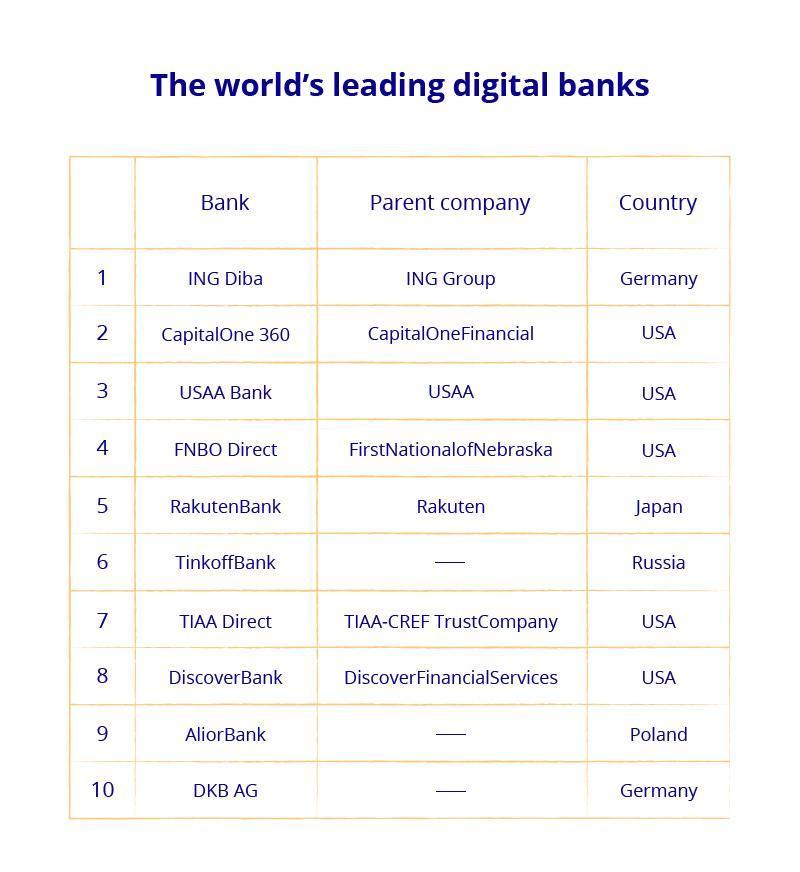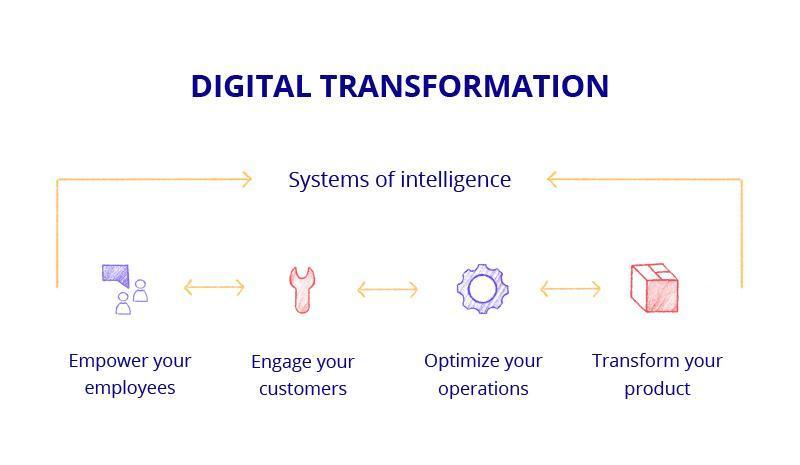Our world is actively perfecting and moving towards a digital transformation economy, which requires companies to review their development strategies. Businesses of all sorts have no choice but to modernize their internal workflows and change approaches to interacting with clients. And financial organizations, of course, are no exception to the rule.
If you acknowledge the inevitability of change but have no idea where to start to keep up to date, do yourself a favor and get some time to read our article. We're describing the main stages of digital transformation in banking and giving a ton of hints and tips, so you’ll definitely find our new blog post useful.
What is digital transformation?
In the 21st century, we, the people, have almost made the Internet our home; moreover, the kids of the new millennium cannot imagine life without mobile devices, wi-fi, and other achievements of modern civilization. That's why digitalization has become such a hot topic. Without the introduction of IT technology, a business simply has no chance to succeed!
Let's start with the digital transformation definition. In general, we're talking about the process of modernizing the company's business model through the use of the most innovative solutions, which means:
-
creation of new digital products;
-
introduction of high technology in the company's business processes;
-
adaptation of the platform to the needs of the organization and its customers.
Effective digital strategy involves not only the installation of state-of-the-art equipment or software but also fundamental changes in approaches to the company’s management, corporate culture, communications with clients, and so on.
Key components of digital transformation in banking and other business areas include:
-
Continuity of the modernization process;
-
Focus on improving competitiveness;
-
Ongoing interaction with breakthrough technologies and innovations;
-
Creating latter-day business models targeted at user requests.
Digital business transformation in the banking industry
Now let’s discuss the concept of digital transformation in relation to the financial sector.
Once upon a time, back in 1994, Bill Gates said a phrase, which turned out to be prophetic: "Banking is necessary - banks are not." Such a statement had sounded rather boldly, but it served as the beginning of the transformation of the banking industry. However, there are still financial companies, which are afraid of innovations. Let's see why.
Why are some banks in no hurry to start digitalization?
-
Banks founded a couple of decades ago usually have infrastructure designed for the physical transfer of paper banknotes and documents. The need to change the entire structure of a business is a troublesome task.
-
In a number of countries, the digital transformation in banking is being hindered by the legislation system itself: among other things, it doesn't allow serving a client without his physical identification.
-
Online banks are highly susceptible to regulatory risks and have more chances to break the laws, which means they can be reprimanded.
-
Also, sometimes cash deposits become a problem. Digital banks usually resort to cash-in partner terminals or their own ATM network in these cases. Though, it's not always enough, since most terminals have restrictions on the amount of money, which can be deposited into the account.
-
And, of course, let’s not forget about the requirements for information security. Not all financial companies know how to correctly approach such a delicate matter.
As you see, there are many difficulties, but the onrush of technology cannot be stopped. And banks wishing to maintain their position will have to accept these challenges sooner or later.
Modern realities
According to forecasts of leading world experts, the Digital Banking market industry is projected to grow to USD 199.38 Billion by 2032, exhibiting a compound annual growth rate (CAGR) of 9.20% during the forecast period (2023–2032). Today, no less than 15 countries are implementing national digitalization programs, including Norway, Denmark (active digitalization of the public sector), the United Kingdom, the USA, Canada (an ICT hub in Toronto), Germany, Australia, Saudi Arabia, India, China (the Internet Plus system, which implies smart integration of digital technologies and their combination with a traditional approach), Russia, South Korea (Creative Economy program), New Zealand, Signature (Smart Economy), and others.

According to Accenture's analysis, over the past year, nearly 20% of representatives of the new millennium (the so-called millennials) have changed their banks. The reason is the increased demands on their own comfort. It’s really difficult to retain such customers, they think differently and are open to everything new, including innovative technologies. They want to be able to use the services of a digital bank with all its advantages: round-the-clock access to a personal account, simplified transactions, and more.
Given these circumstances, the integration of digital-native banking solutions is just a must-have condition!
New business approach
When planning the modernization of your system, you should definitely consider how the digitalization of the financial market will change the business processes of banks. Here are a few key factors you must take into account:
-
There is no need to create a wide network of bank branches anymore since communication with a client face-to-face has become less relevant. By the way, this is already happening in Europe (over the last 10 years in the Netherlands, more than half of the bank offices have been closed).
-
Active digitalization and the development of flexible core systems are intensifying competition and the struggle for customers among members of the financial market. A new group of rivals has appeared, namely, retailers and telecom operators who, too, are now offering microfinance services. In addition, IT giants such as Apple, Google, Amazon, Facebook have become very active in the mobile payment segment. Moreover, these modern payment solutions are being preferred by about 75% of present-day users.
-
New digital banking transformation trends are emerging; they help financial companies attract and retain more clients. Among these trends are chatbots and virtual assistants, which allow businesses to provide 24/7 customer support.
-
Another useful trend is the integration of video to simplify customer service (say, optimizing the process of user interaction with an ATM). About 80% of financial institutions believe that video banking improves client experience and reduces company costs.
Digital transformation leaders in banking
It's time to take a look at digital transformation leaders, what do you think? According to research made by eminent analysts, BankofAmerica, BancoSantander, Barclays, BNP Paribas, BBVA, Citi, JP MorganChase, RBS, HSBC, UniCredit, WellsFargo and SociétéGénérale have achieved the greatest successes in this area.
Let's talk about some of them in more detail to understand which of their steps have enabled them to succeed.
-
BankofAmerica tested the first bank branches without operational personnel. They’re equipped only with ATMs and special rooms for video conferencing with bank employees. Perhaps, in the future, the bank will completely switch to robo-banking.
-
BNP Paribas has allocated about 3 billion euros to implement digital business transformation. The first stages of modernization have already helped the company to reduce the number of bank branches in France by 10% (which, of course, decreases the cost of servicing them either).
-
Barclays is actively developing its mobile application: to date, the program has attracted about 6.5 million loyal users. Besides, Barclays owners are going to add an extra remote service channel (via social media, namely, Facebook).
Digital transformation technology trends
To join the ranks of the leaders described above, it’s very important to follow the latest technological trends, such as…

If we talk about digital banking transformation trends, Artificial Intelligence (AI) and Big Data are of particular interest.
The introduction of AI solutions allows constantly developing your banking platform, conducting credit scoring more accurately, and effectively managing risks. Among other things, it becomes possible to use virtual consultants (which we've already mentioned above). These are intelligent mechanisms able to advise clients on almost all financial matters.
As concerning Big Date, the topic is too important and deserves a separate section (just read on!).
Digital banking isn't just about financial services. Here we're dealing with something bigger... let's take a closer look at the issue, right?
Types of digital banking transformation
There are 4 basic digital banking models:
-
Beyond Banking, which involves establishing partnerships with other companies. The goal is to help the client get a full package of financial services (say, if a person buys real estate, he can expect that his bank will not only provide favorable credit conditions but also offer him additional services like insurance).
-
Digital Marketplace. The bank (usually called FinTech) creates a single e-commerce trading platform providing its retail products and services, including those that belong to partners (travel services, insurance products, purchase of software licenses, popular products). Bank partners gain access to a wide audience of potential customers, and the digital bank has an opportunity to improve relations with existing customers and attract new ones.
-
Banking-as-a-Service, which is usually aimed at the cooperation of various institutions somehow related to the financial area (and the bank can expand and better its sales channels).
-
Inclusive Banking: it implies the provision of all key banking services based on mobile and cloud technologies.
Using Big Data to build a digital transformation strategy
Above, as you probably remember, we mentioned a couple of technological trends and promised to discuss one of them (namely, Big Data) at greater length a bit later. It's time to keep our promise.
The thing is, properly applying big data technology is the key to digital transformation success. And we're ready to reason our case.
Humanity is constantly generating huge amounts of data to help companies run businesses with greater efficiency. To take full advantage of the available information, it's necessary to accumulate, structure, and analyze it. And Big Data technology targeted at processing info streams would come in handy in this respect.
Resorting to a Big Data trend, you can build a digital transformation strategy, which would help you achieve the following:
-
make strategic decisions;
-
understand your customers and predict their behavior;
-
adapt offers to specific clients;
-
create targeted marketing messages;
-
improve the user experience;
-
detect anomalies faster and reduce damage from fraudulent transactions.
Benefits of digital transformation in banking
Let's consider digital transformation perspectives. Put it differently, what are the benefits of introducing high technology?
Increased Competitiveness
One of the digital transformation goals is to help the company increase its own competitiveness. After all, to be successful, you need to be fast, flexible, and ready to respond to the dictates of time. And modern reality requires the smart integration of digital technologies. If the business doesn't adapt to the frantic pace of the 21st century, it won't be able to compete with forward-looking financial organizations.
Cost Savings
According to experts, financial companies can significantly save and reduce costs (up to 25% or even more) by involving large amounts of data and automating work processes (repetitive tasks).
Customer Experience Improvement
Digitalization also allows organizing the most personalized interaction with each client. Of course, such a personalized approach helps to improve customer experience: in the end, any person loves to be offered exactly what he wants to receive and won't mind having his wishes anticipated.
To achieve personalization, companies should resort to innovative digital-native banking solutions including Big Data technologies, artificial intelligence, robotics, etc.
24/7 Customer Interaction
A modern banking core platform will help you constantly stay in touch with your client and more quickly solve his problems. You'll no longer be limited only to the working hours of your employees, which means you'll keep consumers loyal. They'll be able to ask for help from your company around the clock and any day of the week.
Optimization of Bank Employees
Also, keep in mind: if you transform your core business platform through proper digitalization, you'll get the opportunity to automate a lot of routine operations. This means your employees would be able to devote their time to more strategically important tasks.
Effective Partnership
Any successful business strategy necessarily involves a productive partnership. And you can’t do without an effective digital transformation program in this respect either! A company that doesn't use modern technology seems outdated and creates an unfavorable impression. Besides, the introduction of innovative techniques allows conducting business anywhere in the world, therefore, geography ceases to be an obstacle.
Key stages of digital transformation
Surely, there are different paths to digital transformation in banking, but we'd like to highlight 3 key stages of this uneasy process.
-
Drawing up a detailed plan, which implies:
-
analysis of your business needs;
-
determination of the direction of company development;
-
selection of technologies and tools you’re going to use;
-
identifying business weaknesses, which could be an obstruction to actual digital transformations;
-
search for a team of experts to help you implement the project.
-
-
Training employees to deal with new technologies. Your staff should be prepared for any changes in business processes if these changes are needed to increase overall efficiency. Ideally, you have to conduct a series of masterclasses focused on teaching your team members the necessary skills to work in updated conditions.
-
The gradual abandonment of obsolete technologies. The preservation of old technologies also impedes business evolvement, since many valuable resources should be spent on their maintenance. Your digital bank must be based on the most innovative, relevant solutions.

Main secrets of an effective digital transformation program
In fact, there are a lot of such secrets, and we're giving an example of only the most important of them.
The right digital strategy
According to studies, at least 60% of companies incorrectly approach the digitalization process and therefore don’t achieve the expected results. To avoid such a sad outcome, it’s imperative to draw up a preliminary plan (as we wrote above) and develop a competent digital transformation banking strategy. You must understand how the implementation of innovative solutions is going to help you improve your business performance.
Motivated team
Do you remember how we talked about the need to train your staff? But bear in mind, in addition to teaching employees to work with modern technologies, you must motivate your team. It has to see the goal of digital transformation and be inspired by the idea of modernizing the business, as these changes are an inexorable requirement of our time.
Digital business transformation technologies
There’re many diverse technologies, and every day their list is being replenished with more innovative solutions. Therefore, it’s crucial to choose the right tools to drive digital banking transformation.
Base your choice on a thorough analysis. Ask yourself: what technologies will help you improve the platform’s security or better economic performance? It is these tools that should be introduced first.
Regular updates of your digital-native banking solutions
The concept of digital transformation involves the continuous development and improvement of your system. You have to be aware that the process of modernizing a business is endless, and you cannot ever stop. So update your platform on a regular basis to ensure it remains relevant and meets customer expectations.
Competency Center
You’re unlikely to be able to tackle digital transformation yourself, the task is too complicated and requires professional help. The perfect solution is to resort to a competence center, consisting of employees of various profiles, including IT developers, UI/UX experts, marketers, etc.
The step-by-step approach to digital business transformation
And finally, the last condition for success: digital transformation in banking should be gradual, with clear tracking of changes and business strategy adjustment if necessary.
The fact is that the reorganization of any financial services affects a large number of legacy systems, and they cannot be eliminated at once. So, it’s best to act in stages. Take your time, there is no need to hurry!




